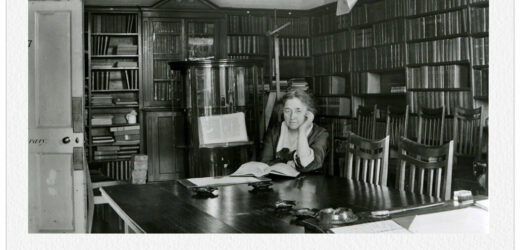When the headmistress at the North London Collegiate School told Lilian Lindsay that she should become a teacher, and that she would block her from finding any other type of work, Lindsay shot back: “You cannot prevent me from being a dentist.”
“I knew nothing of dentistry,” Lindsay wrote in her unpublished autobiography, “but having stated boldly that I was to be a dentist, there was nothing else to be done.”
In the 1890s, there were no certified female dentists in Britain; the profession was considered unladylike and women were seen as physically unsuited to the work.
In her first attempt, in 1892, she was rejected when she applied to study at England’s National Dental Hospital. The dean, Henry Weiss, was so concerned that she would distract the male students that he would only interview her on the sidewalk outside the school.
Later that year she went to Scotland, where the rules were a bit looser. She was admitted as the first female student at the Edinburgh Dental Hospital and School, though not everyone was happy about it.
“Do you realize you will be taking the bread out of the mouth of some poor fellow?” Henry Littlejohn, then regarded as a public health expert, told her.
At Edinburgh, Lindsay struggled to pay for food and lodging, but she was young, determined and inspired by her work.
“There was only enough money, and barely enough, to get me through my classes and examinations,” she wrote in her autobiography. “I must not fail.”
She had found her calling. By the time she got her degree, in 1894, she had won the Wilson Medal for dental surgery and pathology and a medal for academic achievement in medicine and therapeutics.
The next year she was accredited at a meeting of the British Dental Association, becoming the first certified female dentist in Britain. Women were entering the profession in the United States as well in the late 1800s.
She went on to become a notable figure in British dentistry: the first woman president of the British Dental Society, in 1946; the first woman president of the Society for the Study of Orthodontics; and the founder and longtime curator of the British Dental Association Library, which she oversaw for three decades.
She was also the editor of the British Dental Journal and the author of scores of papers and two books, “A Short History of Dentistry,” considered one of the first serious histories of the profession, and a translation of a classic French text called “The Dental Surgeon.”
An article in the British Dental Journal, written after her death, described her as having “a forceful yet retiring, caring, focused, modest, humorous and engaging personality.”
A shorthand typist who worked at the library when Lindsay was in her 60s, Florence Messner, said she always dressed in black with her wavy gray hair pulled back into a small bun, and wore gold wire-rimmed glasses that “showed her eyes to advantage — very steady, clear ones, and kind.”
Lindsay had opened the door for women dentists, and although change came slowly, today more than half of dentists in Britain are women, according to the General Dental Council, which regulates the profession there.
Lilian Murray was born on July 24, 1871, in Holloway, London, the third of 11 children of James Morrison Murray, a church organist and singing teacher, and Margaret Amelia (Bennett) Murray.
The family struggled after Murray died in 1885, and Lindsay won a scholarship to the North London Collegiate School. It was there that the headmistress, Frances Buss, insisted she become a teacher. When Lindsay refused, the headmistress withdrew her scholarship, forcing her to leave the school in 1889 and set out on her own.
In the United States, the first woman to establish herself in a regular dental practice was Emeline Roberts Jones, who joined her husband’s practice in 1859. She persuaded him to let her join by secretly working on extracted teeth and presenting him with a two-quart jar of teeth she had filled. Later she set up her own office in New Haven, Conn.
Lucy Hobbs Taylor was the first American woman to earn a degree in dentistry, in 1866. “People were amazed,” one critic wrote, “when they learned that a young girl had so far forgotten her womanhood as to want to study dentistry.” She taught the skill to her husband, a Civil War veteran and railroad-car painter, and they opened a practice together in Lawrence, Kansas.
The first professional dentist in America, Ms. Lindsay wrote in an essay, was Robert Woofendale who traveled from Britain to the colonies in 1766, where he made what she said was “the first full set” of false teeth “ever seen in America.”
Others, including the patriot Paul Revere, a silversmith, did dental work as a sideline.
On her first day at Edinburgh she met her future husband, Robert Lindsay, a faculty member. They married in 1905 when she was 34 and he was 40. He died in 1930.
Among the more notable professors she encountered in Edinburgh were William Bowman MacLeod, who was known for his study of the effects of bagpipe playing on the teeth; and Joseph Bell, whose gift for unexpected deductions led one of his students, Arthur Conan Doyle, to use him as the model for his fictional detective, Sherlock Holmes.
Lilian Lindsay moved to London, where she spent the next decade practicing to pay off her student loan, then went into practice with her husband in Edinburgh.
In 1920, Robert Lindsay was appointed dental secretary of the British Dental Association. The couple moved to London, where Lilian established the British Dental Association Library, cultivating it over the next 30 years into one of most comprehensive dental libraries in Europe.
Exploring the context for her own achievements, she became one of the first people in Britain to take a serious interest in the history of dentistry.
She learned French, German, Latin and some Old English and Spanish to expand her reading. Her history of dentistry and published papers are rich with detail about the “strange and terrible” procedures of previous centuries: The dental charlatans of the 14th century who extracted teeth “at the tip of a sword” as brass bands played to gather a crowd; dental transplants using teeth of sheep or dogs or even baboons; an army officer who ordered an aide to stand by during a transplant in case one of his teeth was needed; and the quirky king who asked his dentist to hand him a glass of brandy, not to drink but “to be sure that his hand was steady.”
Over the years Lindsay’s stature rose as she accumulated several honorary degrees and memberships and became the first woman to hold a number of influential positions in dentistry.
In 1946 she was named a Commander of the British Empire, an honor that is one rank below a knighthood.
Lindsay died on Jan. 31, 1960. She was 89.
By the time she sat down to write her autobiography, she had developed a new perspective on her confrontation a half-century earlier with Buss, the autocratic headmistress.
“Perhaps,” she wrote, she had misjudged Buss “owing to a feeling of resentment which changed later.”
“There are natures which need opposition and obstacles to effect a purpose,” she wrote. Her sentiments over time had “softened to a feeling of gratitude and an acknowledgment that Miss Buss was, after all, the ‘divinity that shapes our ends.’”
Source: Read Full Article


